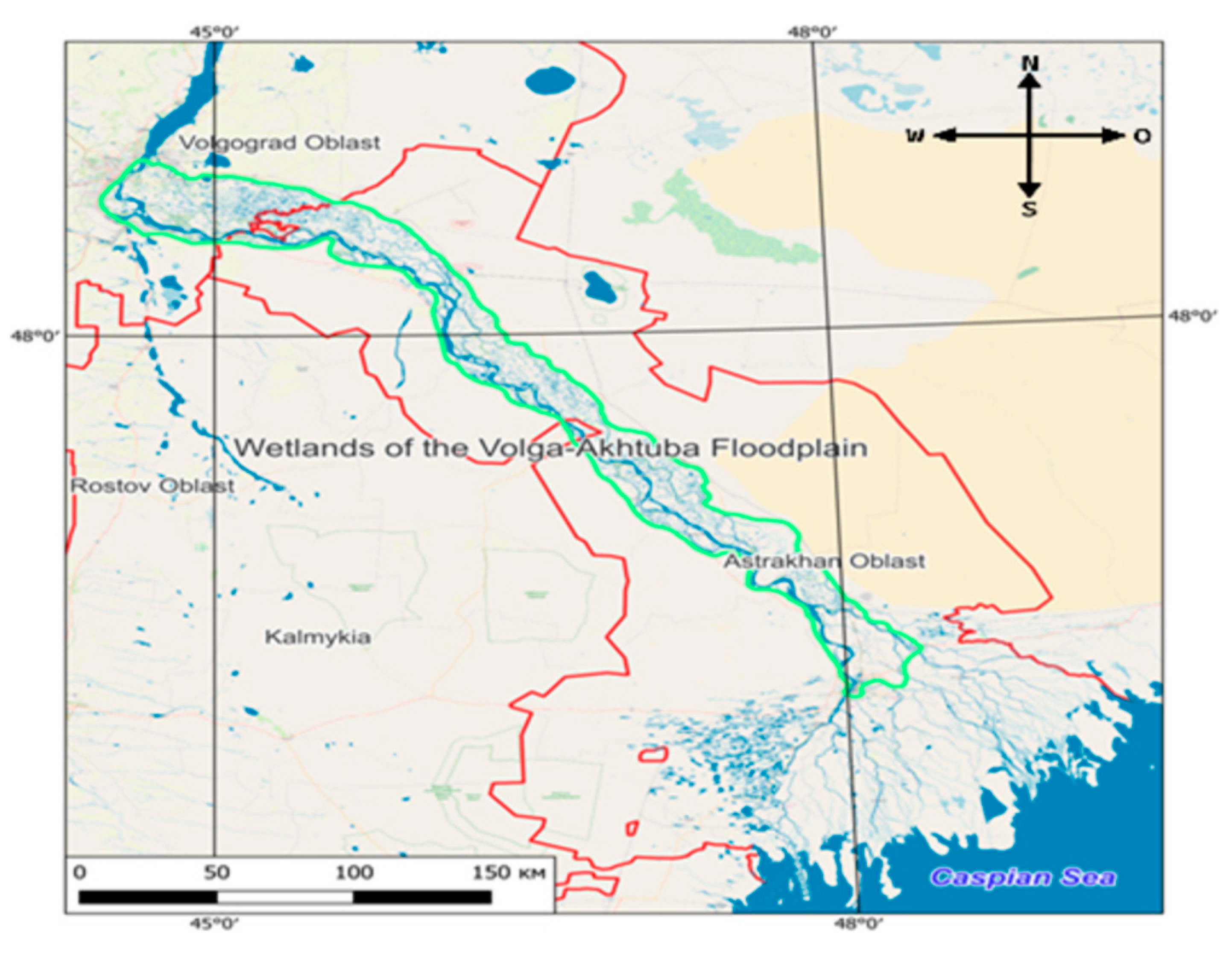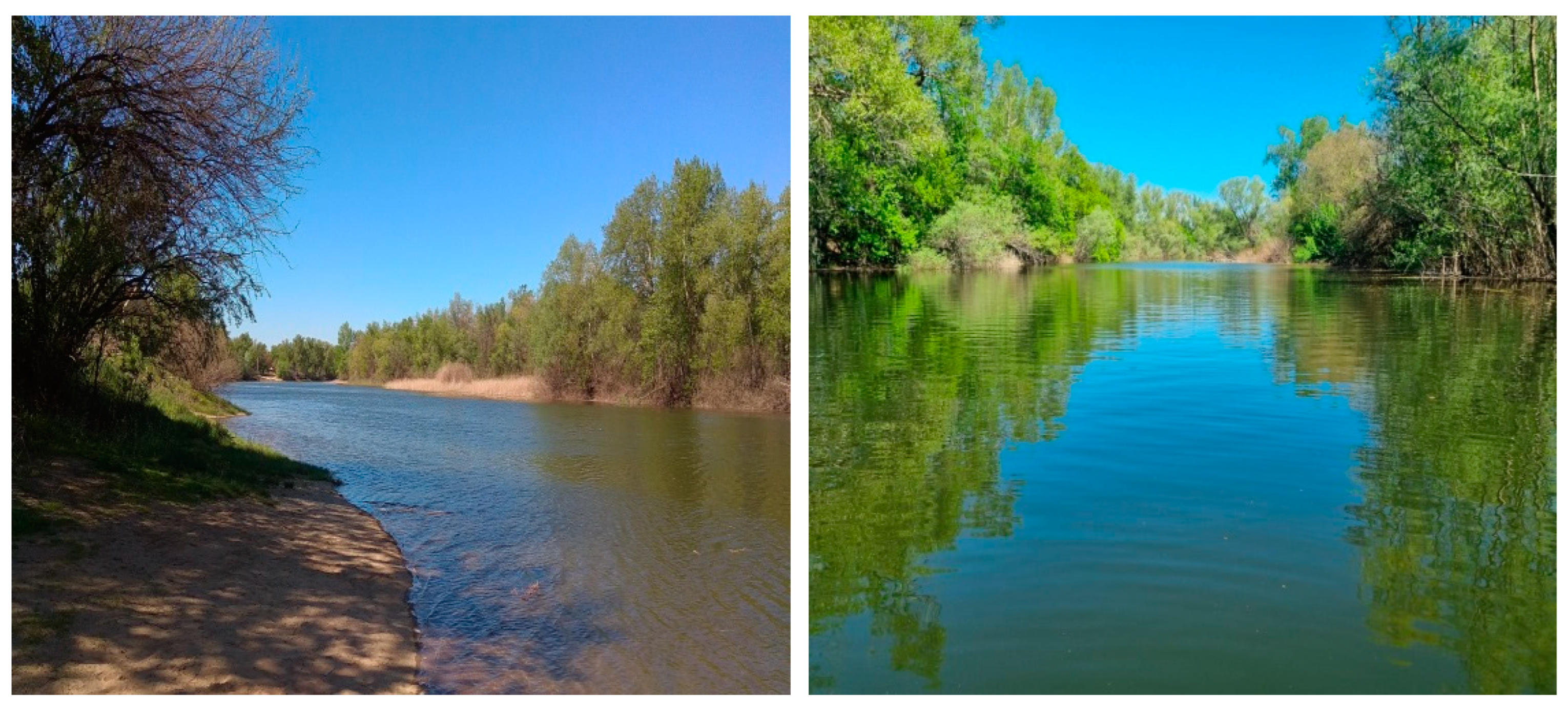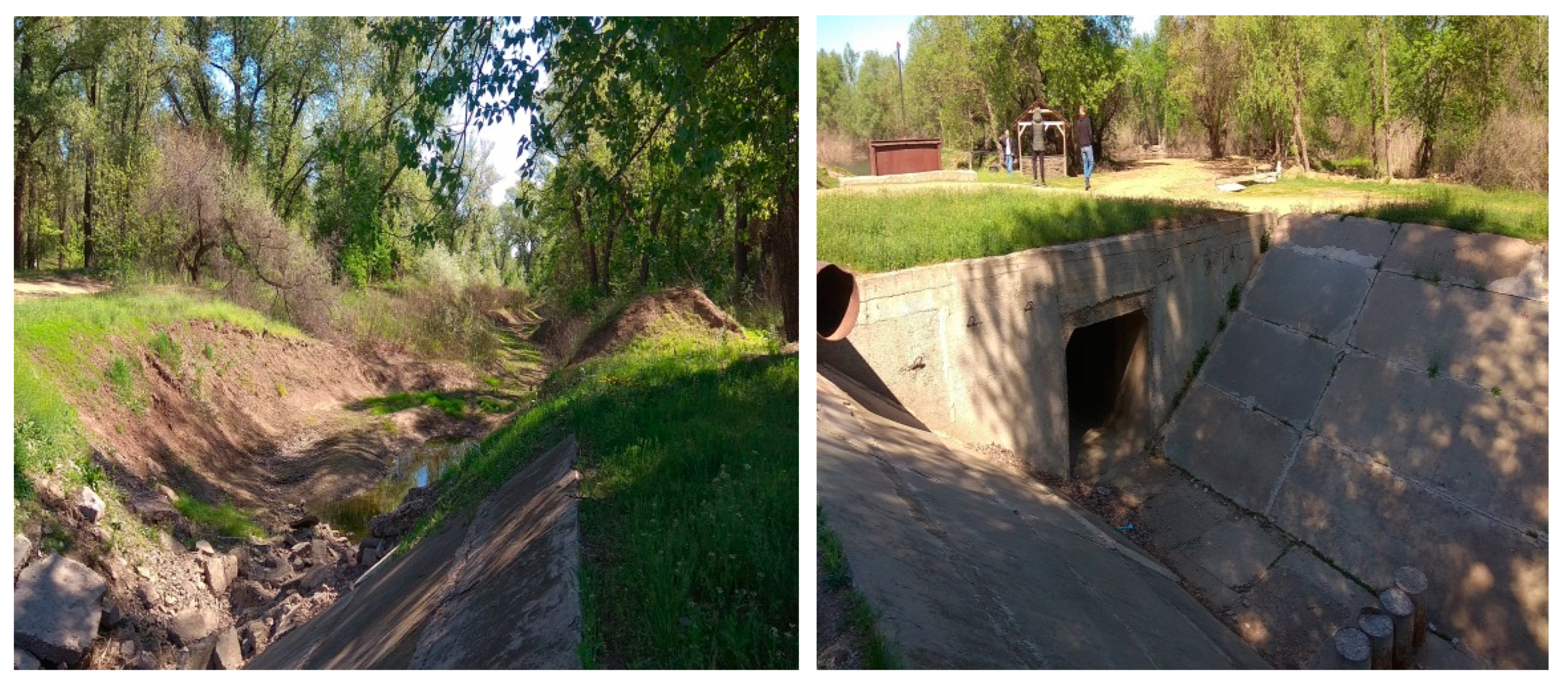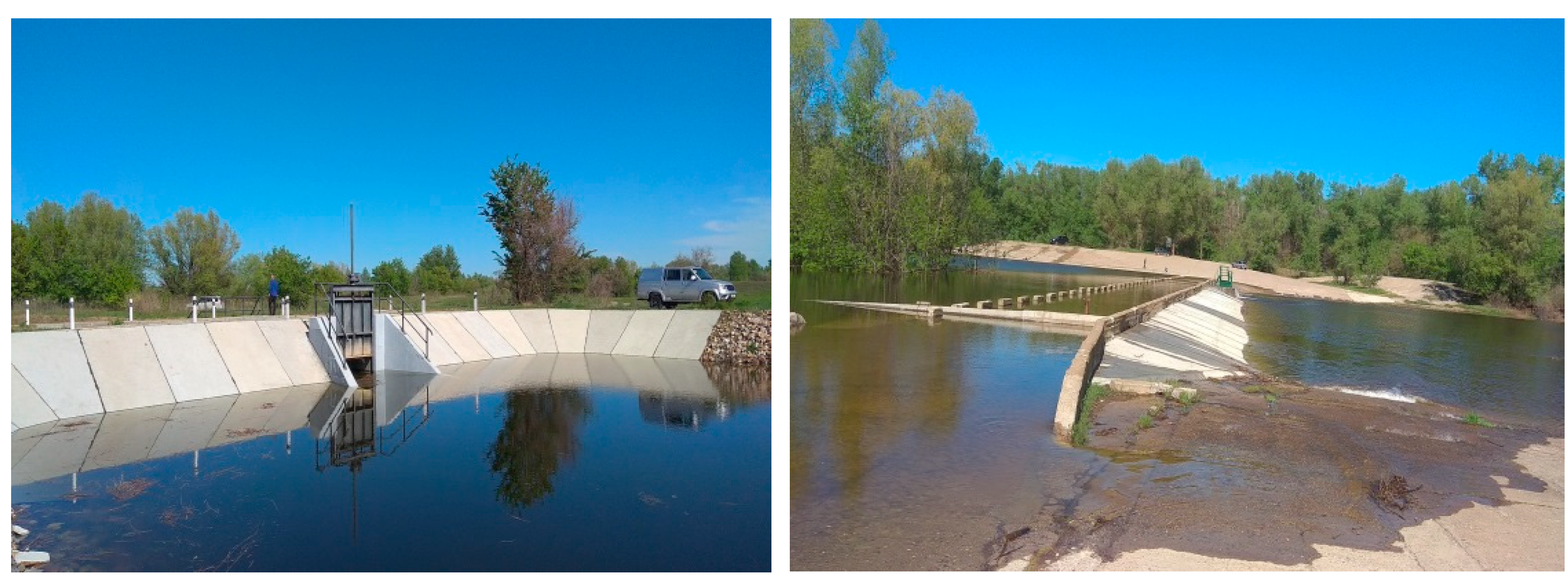Assessment of Ecosystem Services of Wetlands of the Volga–Akhtuba Floodplain
Abstract
:1. Introduction
2. Materials and Methods
2.1. Case Study Sites
2.1.1. Assessment of the Ecological State of the Wetlands of the Volga–Akhtuba Floodplain
2.1.2. Engineering Parameters of the Project “Additional Flooding of the Akhtuba River and the Volga–Akhtuba Floodplain”
- Pumping station;
- The hydroelectric power station building, consisting of three units with a total capacity of 31.2 MW;
- Dam regulators with a crest height of 2.6 m with a maximum water level of −0.7 m;
- The system of hydraulic structures on large rivers will allow the floodplain to receive the necessary water, regardless of the discharges of the Volga hydroelectric power station;
- A 32 km long culvert with a possible throughput capacity of 165–1000 m3 s−1;
- Estuary (reservoir) with a mark from −10 to −3 m, depending on the season.
2.2. Data Collection
2.3. Data Analyses
2.4. Caveats of Study
3. Results
4. Discussion
5. Conclusions
Author Contributions
Funding
Institutional Review Board Statement
Informed Consent Statement
Data Availability Statement
Conflicts of Interest
References
- Kablov, V.F.; Kostin, V.E.; Sokolova, N.A. Volga-Akhtuba Floodplain. Ecological Situation: Problems and Solutions for Its Improvement; VPI Volgstu: Volgograd, Russia, 2015. [Google Scholar]
- Golub, V.B.; Chuvashov, A.V.; Bondareva, V.V.; Gerasimova, K.A.; Nikolaichuk, L.F. The change in the composition of the flora of the Volga-Akhtuba floodplain after the regulation of the water flow of the Volga River. Arid. Ecosyst. 2020, 26, 54–61. [Google Scholar]
- Brylev, V.A.; Streltsova, E.N.; Aristov, A.V. Changes in geomorphological processes and landscapes in the Volga-Akhtuba floodplain in connection with the regulation of the hydrological regime of the Volga. Geomorphology 2001, 3, 87–94. [Google Scholar]
- Brylev, V.A.; Ovcharova, A.Y. Changes in natural processes in the Volga-Akhtuba floodplain and the lower reaches of the Balta River. Nat. Syst. Resour. 2015, 2, 87–96. [Google Scholar]
- The Designers Showed How the Water through the New Hydroelectric Station Bypassing the Volga Will Flow into the Floodplain. Available online: https://www.volgograd.kp.ru/daily/27080/4152772/ (accessed on 28 May 2022).
- Waycott, M.; Duarte, C.M.; Carruthers, T.J.; Orth, R.J.; Dennison, W.C.; Olyarnik, S. Accelerating loss of seagrasses across the globe threatens coastal ecosystems. Proc. Natl. Acad. Sci. USA 2009, 106, 12377–12381. [Google Scholar] [CrossRef] [PubMed]
- Davidson, N. How much wetland has the world lost? Long-term and recent trends in global wetland area. Mar. Freshw. Res. 2014, 65, 936–941. [Google Scholar]
- An Introduction to the Convention on Wetlands (Previously the Ramsar Convention Manual); Ramsar Convention Secretariat: Gland, Switzerland, 2016; Available online: https://abs.igc.by/wp-content/uploads/2016/04/Introduction-to-the-Convention-on-Wetlands.-Ramsar-Handbooks-5th-Edition-2016.pdf (accessed on 1 July 2022).
- Clarkson, B.; Ausseil, A.-G.; Gerbeaux, P. Wetland ecosystem services. In Ecosystem Services in New Zealand; Dymond, J.R., Ed.; Manaaki Whenua Press: Lincoln, New Zealand, 2014; pp. 192–202. [Google Scholar]
- Sierra, L.; Marin, W.; Castro, L.G.; Hernández-Manrique, O.L. Economic Valuation of Benefits in Freshwater Ecosystems: Complex Wetlands System Belonging to the San Juan River in the Magdalena Medio Region, Colombia. Sustainability 2021, 13, 5374. [Google Scholar] [CrossRef]
- Alexander, S.; McInnes, R. The Benefits of Wetland Restoration; Ramsar Scientific and Technical Briefing Note no.4; Ramsar Convention Secretariat: Gland, Switzerland, 2012. [Google Scholar]
- Chen, Z.M.; Chen, G.Q.; Chen, B.; Zhou, J.B.; Yang, Z.F.; Zhou, Y. Net ecosystem services value of wetland: Environmental economic account. Commun. Nonlinear Sci. Numer. Simul. 2009, 14, 2837–2843. [Google Scholar] [CrossRef]
- Sun, B.; Lei, Y.; Cui, L.; Li, W.; Kang, X.; Zhang, M. Addressing the modelling precision in evaluating the ecosystem services of coastal wetlands. Sustainability 2018, 10, 1136. [Google Scholar] [CrossRef]
- Meng, L.; Dong, J. LUCC and Ecosystem Service Value Assessment for Wetlands: A Case Study in Nansi Lake, China. Water 2019, 11, 1597. [Google Scholar] [CrossRef]
- Bobylev, S.N.; Goryacheva, A.A. Identification and assessment of ecosystem services: An international context. Int. Organ. Res. J. 2019, 14, 225–236. [Google Scholar] [CrossRef]
- Russi, D.; ten Brink, P.; Farmer, A.; Badura, T.; Coates, D.; Förster, J.; Kumar, R.; Davidson, N. The Economics of Ecosystems and Biodiversity for Water and Wetlands; IEEP: London, UK; Brussels, Belgiumt; Ramsar Secretariat: Gland, Switzerland, 2013. [Google Scholar]
- Pascual, U.; Muradian, R.; Brander, L.; Gomez-Baggethun, E.; Martín-López, B.; Verma, M.; Armsworth, P.; Christie, M.; Cornelissen, J.; Eppink, F.; et al. The Economics of Valuing Ecosystems Services and Biodiversity. Chapter 5. TEEB Project. 2010. Available online: https://www.researchgate.net/publication/303444184 (accessed on 28 May 2022).
- Grygoruk, M.; Miroslaw-Swiatek, D.; Chrzanowska, W.; Ignar, S. How Much for Water? Economic Assessment and Mapping of Floodplain Water Storage as a Catchment-Scale Ecosystem Service of Wetlands. Water 2013, 5, 1760–1779. [Google Scholar] [CrossRef]
- Morris, J.; Camino, M. Economic Assessment of Freshwater, Wetland and Floodplain (FWF) Ecosystem Services. In UK NEA Economics Analysis Report; Cranfield University: Bedford, UK, 2011; Available online: https://www.cbd.int/financial/values/unitedkingdom-economicfreshwaters.pdf (accessed on 29 May 2022).
- Turner, R.K.; Georgiou, S.; Fisher, B. Valuing Ecosystem Services. The Case of Multi-Functional Wetlands; Earthscan: London, UK, 2008. [Google Scholar]
- Korneeva, E.A. Efficiency of financing of forest reclamation measures for ensuring sustainable development of agricultural regions in the South of the European territory of Russia. Econ. Reg. 2020, 16, 871–883. [Google Scholar]
- Korneeva, E.A. Economic Assessment and Management of Agroforestry Productivity from the Perspective of Sustainable Land Use in the South of the Russian Plain. Forests 2022, 13, 172. [Google Scholar] [CrossRef]
- Shashko, D.I. Agro-Climatic Resources of the USSR; Hydrometeoizdat: Leningrad, Russia, 1985. [Google Scholar]
- Pavlova, V. Watering of the Volgo-Akhtuba floodplain as the most important project for rehabilitation of the Volga. Hydraul. Eng. 2020, 2, 36–37. [Google Scholar]
- Report “On the State of the Environment of the Volgograd Region in 2019”. In Committee of Natural Resources, Forestry and Ecology of the Volgograd Region; Sazonov, V.E. (Ed.) TEMPORA: Volgograd, Russia, 2020; Available online: https://oblkompriroda.volgograd.ru/upload/iblock/65e/Ekologiya_2020_.pdf (accessed on 20 May 2022).
- The Official Portal of the Department of Statistics of Agriculture and the Environment in the Volgograd Region. Available online: https://volgograd.bizly.ru/1395618246-otdel-statistiki-selskogo-hozyaystva-i-okruzhayuschey-prirodnoy-sredi/ (accessed on 19 June 2022).
- Kanishchev, S.N.; Solodovnikov, D.A.; Zolotarev, D.V.; Shinkarenko, S.S.; Kursakova, N.A. Recreational Nature Management on the Territory of the Volga-Akhtuba Floodplain and the Volga Delta: Methodological Recommendations for Rationing Recreational Loads and Assessing the State of Natural Complexes; Tsaritsyn Printing Company: Volgograd, Russia, 2012. [Google Scholar]
- Mukha, T.P. The influence of forest strips on reducing the dustiness of atmospheric air in agricultural landscapes. In Protective Afforestation and Its Effectiveness; Stepanov, A.M., Ed.; All-Russian Research Institute of Agroforestry: Volgograd, Russia, 1990; pp. 104–108. [Google Scholar]
- Volgograd Region in Numbers. In 2020: Brief Collection. Territorial Administration of the Federal State Service Statistics for Volgograd; Volgogradstat: Volgograd, Russia, 2021; Available online: https://volgastat.gks.ru/storage/mediabank/whW83IA5/02_2020_31052021.pdf (accessed on 20 May 2022).
- Finlayson, M.; Cruz, R.D.; Davidson, N.C.; Alder, J.; Cork, S.; Groot, R.; Lévêque, C.; Milton, G.R.; Peterson, G.D.; Pritchard, D.; et al. Millennium Ecosystem Assessment: Ecosystems and Human Well-Being: Wetlands and Water Synthesis; World Resources Institute: Washington, DC, USA, 2005; p. 70. Available online: https://www.researchgate.net/publication/40117503_Millennium_Ecosystem_Assessment_Ecosystems_and_human_well-being_wetlands_and_water_synthesis (accessed on 29 May 2022).
- Christie, M.; Rayment, M. An economic assessment of the ecosystem service benefits derived from the SSSI biodiversity conservation policy in England and Wales. Ecosyst. Serv. 2012, 1, 70–84. [Google Scholar] [CrossRef]
- Tinch, R.; Beaumont, N.; Sunderland, T.; Ozdemiroglu, E.; Barton, D.; Bowe, C.; Börger, T.; Burgess, P.; Cooper, C.N.; Faccioli, M.; et al. Economic valuation of ecosystem goods and services: A review for decision makers. J. Environ. Econ. Policy 2019, 8, 359–378. [Google Scholar] [CrossRef]
- Emerton, L. Economic Valuation of Wetlands: Total Economic Value. In The Wetland Book; Finlayson, C.M., Everard, M., Irvine, K., McInnes, R.J., Middleton, B.A., van Dam, A.A., Davidson, N.C., Eds.; Springer Science: Berlin/Heidelberg, Germany, 2016; pp. 1–6. [Google Scholar]
- Korneeva, E.A. Economic Evaluation of Ecological Restoration of Degraded Lands through Protective Afforestation in the South of the Russian Plain. Forests 2021, 12, 1317. [Google Scholar] [CrossRef]
- Korneeva, E.A.; Belyaev, A.I. Assessment of Ecological and Economic Efficiency of Agroforestry Systems in Arid Conditions of the Lower Volga. Forests 2022, 13, 1248. [Google Scholar] [CrossRef]
- Barbier, E.; Acreman, M.; Knowler, D. Economic Valuation of Wetlands: A Guide for Policy Makers and Planners; Ramsar Convention Bureau: Gland, Switzerland, 1997. [Google Scholar]
- Haines-Young, R.; Potschin, M.B. Common International Classification of Ecosystem Services (CICES) V5.1 and Guidance on the Application of the Revised Structure. 2018. Available online: https://www.cices.eu (accessed on 20 July 2022).
- OECD. Purchasing Power Parities (PPP) (Indicator). 2022. Available online: https://doi.org/10.1787/1290ee5a-en (accessed on 20 July 2022).
- The Official Portal of the Municipal Unitary Enterprise “Waterchannel”, Volzhsky, Russia. 2022. Available online: https://www.vkanal.ru/subscribers/tariff/ (accessed on 18 July 2022).
- Draft Resolution of the Volgograd Region Administration Dated September 18, 2020 “On the Determination of Fees for Individuals Who Do Not Live in Settlements Located within the Boundaries of Specially Protected Natural Territories for Visiting Specially Protected Natural Territories of Regional Significance”. Available online: https://buhpressa.ru/dlya-bukhgaltera/normativnye-dokumenty/196-regionalnye-organy-vlasti/8604-proekt-postanovleniya-administratsii-volgogradskoj-oblasti-ot-18-sentyabrya-2020-g-ob-opredelenii-platy-dlya-fizicheskikh-lits-za-poseshchenie-osobo-okhranyaemykh-prirodnykh-territorij-regionalnogo-znacheniya (accessed on 19 July 2022).
- Indicators of the Costs of Restoring the Disturbed State of the Environment. Federal Service for Supervision of Nature Management Methodological Development of the Federal State Unitary Enterprise Federal Center of Geoecological Systems. 2009. Available online: https://davaiknam.ru/text/federalenaya-slujba-po-nadzoru-v-sfere-prirodopolezovaniya-pok (accessed on 18 July 2022).
- Financial Portal «IFinance». Inflation in Russia by Year: 1991–2022. Available online: http://global-finances.ru/inflyatsiya-v-rossii-po-godam/ (accessed on 18 July 2022).
- Letter of the Ministry of Economic Development of the Russian Federation Dated December 7, 2018 No 36097-AT/D03i Forecasts of Socio-Economic Development of the Russian Federation. Available online: https://www.economy.gov.ru/material/directions/makroec/prognozy_socialno_ekonomicheskogo_razvitiya/pismo_minekonomrazvitiya_rossii_ot_7_dekabrya_2018_g_36097_atd03i.html (accessed on 19 July 2022).
- Turpie, J.; Lannas, K.; Scovronick, N.; Louw, A. Wetland Valuation Volume, I. In Wetland Ecosystem Services and Their Valuation: A Review of Current Understanding and Practice; Water Research Commission: Gezina, South Africa, 2010. [Google Scholar]
- Barbier, E.B. Valuing Ecosystem Services for Coastal Wetland Protection and Restoration: Progress and Challenges. Resources 2013, 2, 213–230. [Google Scholar] [CrossRef]
- Barbier, E.B. Capitalizing on Nature: Ecosystems as Natural Assets; Cambridge University Press: Cambridge, UK, 2011. [Google Scholar]
- Asare, E.; Chrystal, M.-P.; Anderson, E.; Belcher, K.; Clark, R. Evaluating ecosystem services for agricultural wetlands: A systematic review and meta-analysis. Wetl. Ecol. Manag. 2022, 1–21. [Google Scholar]
- Mitsch, W.J.; Gosselink, J.G. The value of wetlands: Importance of scale and landscape setting. Ecol. Econ. 2000, 35, 25–33. [Google Scholar] [CrossRef]
- Xu, X.; Chen, M.; Yang, G.; Jiang, B.; Zhang, J. Wetland ecosystem services research: A critical review. Glob. Ecol. Conserv. 2020, 22, e01027. [Google Scholar] [CrossRef]
- Sinha, P.; Ringold, P.; Houtven, G.V.; Krupnick, A. Using a final ecosystem goods and services approach to support policy analysis. Ecosphere 2018, 9, e02382. [Google Scholar] [CrossRef]
- Rasmussen, L.V.; Mertz, O.; Christensen, A.E.; Danielsen, F.; Dawson, N.; Xaydongvanh, P. A combination of methods needed to assess the actual use of provisioning ecosystem services. Ecosyst. Serv. 2016, 17, 75–86. [Google Scholar] [CrossRef]
- De Groot, R.; Brander, L.; van der Ploeg, S.; Costanza, R.; Bernard, F.; Braat, L.; Christie, M.; Crossman, N.; Ghermandi, A.; Hein, L.; et al. Global estimates of the value of ecosystems and their services in monetary unit. Ecosys. Serv. 2012, 1, 50–61. [Google Scholar] [CrossRef]
- Brander, L.; Brouwer, R.; Wagtendonk, A. Economic valuation of regulating services provided by wetlands in agricultural landscapes: A meta-analysis. Ecol. Eng. 2013, 56, 89–96. [Google Scholar] [CrossRef]
- Cadastral Value of Land. Available online: https://soil-db.ru/soilatlas/razdel-8-ispolzovanie-zemelnyh-resursov-i-pochv/8-1-rossiyskaya-federaciya/kadastrovaya-stoimost-zemel (accessed on 1 September 2022).
- Woodward, R.T.; Wui, Y.S. The economic value of wetland services: A meta-analysis. Ecol. Econ. 2001, 37, 257–270. [Google Scholar] [CrossRef]
- Manaenkov, A.S.; Korneeva, E.A. Biogeographic aspects of assessing the effectiveness of protection of arable land by forest strips. Vestn. Mosk. Univ. Seriya 5 Geografiya 2021, 3, 48–54. [Google Scholar]
- TEEB. The Economics of Ecosystems and Biodiversity in National and International Policy Making; ten Brink, P., Ed.; Earthscan: London, UK, 2011. [Google Scholar]
- TEEB. The Economics of Ecosystems and Biodiversity in Business and Enterprise; Bishop, J., Ed.; Earthscan: London, UK, 2012. [Google Scholar]




| Ecosystem Service | Value | Evaluation Method | Biophysical Indicator | Reference of Biophysical Indicators | Unit Price (2021: Price in USD Calculated Using PPP [38]) | Reference of Unit Prices |
|---|---|---|---|---|---|---|
| Provisioning: water used for drinking and other household use | Direct use Value | Market prices: cold water | 375 thousand m3 of water | [25,26] | USD 0.69 per m3 | [39] |
| Provisioning: fish caught | Direct use Value | Market price: fish | 144 tons of fish | [27] | USD 3.66 per kg | Local market |
| Cultural: Recreational | Direct use Value | Market price: stay fee | 300 thousand people | [27] | USD 2.32 per user | [40] |
| Regulation and maintenance: Water purification | Indirect use Value | Replacement cost: water treatment | 375 thousand m3 of water | [25,26] | USD 0.92 per m3 | [39] |
| Regulation and maintenance: Air purification | Indirect use Value | Replacement cost: air treatment | 0.85 millions of tons of dust | [28] | USD 0.73 per ton | [41,42] |
| Calculated Indicators | Floodplain Flooding Level, % of the Total Area | ||||
|---|---|---|---|---|---|
| 10 | 40 | 60 | 80 | 100 | |
| 2026 | 2029 | 2031 | 2033 | 2035 | |
| Start of Construction of Hydraulic Structures | Debugging of Hydraulic Structures, Clearing of Territory and Reservoirs | Full Operation of Hydraulic Structures | |||
| Provisioning services: | |||||
| The standard of water consumption for household needs of the population, thousand (m3/year) | 37.5 | 150.0 | 225.0 | 300.0 | 375.0 |
| Projected/estimated catch of fish (tons year−1) | 14.4 | 57.6 | 86.4 | 115.2 | 144.0 |
| Economic value of water for drinking and household use (USD year−1) | 31,481 | 141,647 | 229,808 | 331,414 | 448,071 |
| Economic value of fish (USD year−1) | 64,122 | 288,516 | 468,089 | 675,046 | 912,663 |
| Cultural services: | |||||
| Recreational capacity of wetlands (thousand people/year) | 30 | 120 | 180 | 240 | 300 |
| Economic value of recreation (USD year−1) | 84,679 | 381,010 | 618,150 | 891,455 | 1,205,247 |
| Regulation and maintenance services: | |||||
| The standard of water consumption for household needs of the population (thousand m3/year) | 37.5 | 150.0 | 225.0 | 300.0 | 375.0 |
| The amount of filtered dust (million tons/year) | 0.85 | 0.85 | 0.85 | 0.85 | 0.85 |
| Economic value of water purification (USD year−1) | 41,975 | 188,863 | 306,411 | 441,885 | 597,428 |
| Economic value of air purification (USD year−1) | 754,933 | 849,197 | 918,492 | 993,440 | 1,074,505 |
| The economic value of ecosystem services for the year when the system is full operating (USD year−1) | - | - | - | - | 4.238 million |
| Economic Value of Ecosystem Services | 2007 (The Initial Level) | 2026 | 2029 | 2031 | 2033 | 2035 (The Forecast Level) |
|---|---|---|---|---|---|---|
| Area of restored wetlands, ha | - | 1570 | 6282 | 9422 | 12,563 | 15,704 |
| Economic value of provisioning services | 35 | 61 | 68 | 74 | 80 | 87 |
| Economic value of cultural services | 31 | 54 | 61 | 66 | 71 | 77 |
| Economic value of regulation and maintenance services | 43 | 75 | 84 | 91 | 98 | 106 |
| Total economic value | 109 | 190 | 213 | 231 | 249 | 270 |
Publisher’s Note: MDPI stays neutral with regard to jurisdictional claims in published maps and institutional affiliations. |
© 2022 by the authors. Licensee MDPI, Basel, Switzerland. This article is an open access article distributed under the terms and conditions of the Creative Commons Attribution (CC BY) license (https://creativecommons.org/licenses/by/4.0/).
Share and Cite
Belyaev, A.I.; Pugacheva, A.M.; Korneeva, E.A. Assessment of Ecosystem Services of Wetlands of the Volga–Akhtuba Floodplain. Sustainability 2022, 14, 11240. https://doi.org/10.3390/su141811240
Belyaev AI, Pugacheva AM, Korneeva EA. Assessment of Ecosystem Services of Wetlands of the Volga–Akhtuba Floodplain. Sustainability. 2022; 14(18):11240. https://doi.org/10.3390/su141811240
Chicago/Turabian StyleBelyaev, Alexander I., Anna M. Pugacheva, and Evgenia A. Korneeva. 2022. "Assessment of Ecosystem Services of Wetlands of the Volga–Akhtuba Floodplain" Sustainability 14, no. 18: 11240. https://doi.org/10.3390/su141811240
APA StyleBelyaev, A. I., Pugacheva, A. M., & Korneeva, E. A. (2022). Assessment of Ecosystem Services of Wetlands of the Volga–Akhtuba Floodplain. Sustainability, 14(18), 11240. https://doi.org/10.3390/su141811240






